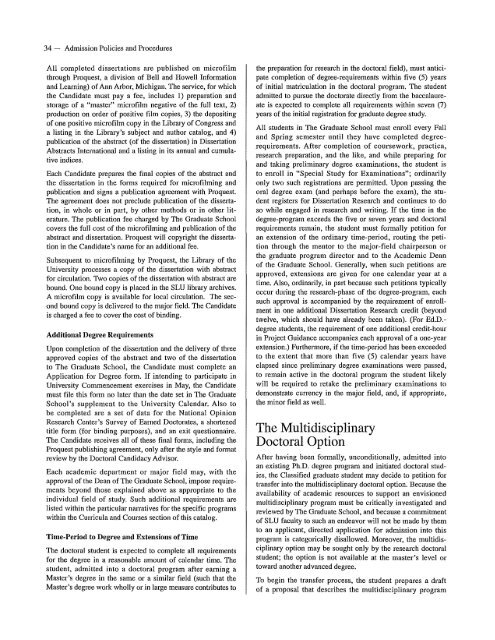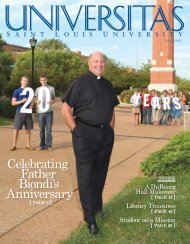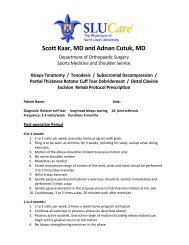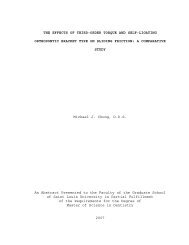Program Manual - Saint Louis University
Program Manual - Saint Louis University
Program Manual - Saint Louis University
Create successful ePaper yourself
Turn your PDF publications into a flip-book with our unique Google optimized e-Paper software.
34 Admission Policies and Procedures<br />
All completed dissertations are published on microfilm<br />
through Proquest, a division of Bell and Howell Information<br />
and Learning) of Ann Arbor, Michigan. The service, for which<br />
the Candidate must pay a fee, includes 1) preparation and<br />
storage of a "master" microfilm negative of the full text, 2)<br />
production on order of positive film copies, 3) the depositing<br />
of one positive microfilm copy in the Library of Congress and<br />
a listing in the Library's subject and author catalog, and 4)<br />
publication of the abstract (of the dissertation) in Dissertation<br />
Abstracts International and a listing in its annual and cumulative<br />
indices.<br />
Each Candidate prepares the final copies of the abstract and<br />
the dissertation in the forms required for microfilming and<br />
publication and signs a publication agreement with Proquest.<br />
The agreement does not preclude publication of the dissertation,<br />
in whole or in part, by other methods or in other literature.<br />
The publication fee charged by The Graduate School<br />
covers the full cost of the microfilming and publication of the<br />
abstract and dissertation. Proquest will copyright the dissertation<br />
in the Candidate's name for an additional fee.<br />
Subsequent to microfilming by Pl'Oquest, the Library of the<br />
<strong>University</strong> processes a copy of the dissertation with abstract<br />
for circulation. Two copies of the dissertation with abstract are<br />
bound. One bound copy is placed in the SLU library archives.<br />
A microfilm copy is available for local circulation. The second<br />
bound copy is delivered to the major field. The Candidate<br />
is charged a fee to cover the cost of binding.<br />
Additional Degree Requirements<br />
Upon completion of the dissertation and the delivery of three<br />
approved copies of the abstract and two of the dissertation<br />
to The Graduate School, the Candidate must complete an<br />
Application for Degree form. If intending to participate in<br />
<strong>University</strong> Commencement exercises in May, the Candidate<br />
must file this form no later than the date set in The Graduate<br />
School's supplement to the <strong>University</strong> Calendar. Also to<br />
be completed are a set of data for the National Opinion<br />
Research Center's Survey of Earned Doctorates, a shortened<br />
title form (for binding pUlposes), and an exit questionnaire.<br />
The Candidate receives all of these final forms, including the<br />
Proquest publishing agreement, only after the style and format<br />
review by the Doctoral Candidacy Advisor.<br />
Each academic department or major field may, with the<br />
approval of the Dean of The Graduate School, impose requirements<br />
beyond those explained above as appropriate to the<br />
individual field of study. Such additional requirements are<br />
listed within the particular narratives for the specific programs<br />
within the Curricula and Courses section of this catalog.<br />
Time-Period to Degree and Extensions of Time<br />
The doctoral student is expected to complete all requirements<br />
for the degree in a reasonable amount of calendar time. The<br />
student, admitted into a doctoral program after earning a<br />
Master's degree in the same or a similar field (such that the<br />
Master's degree work wholly or in large measure contributes to<br />
the preparation for research in the doctoral field), must anticipate<br />
completion of degree-requirements within five (5) years<br />
of initial matriculation in the doctoral program. The student<br />
admitted to pursue the doctorate directly from the baccalaureate<br />
is expeeted to complete all requirements within seven (7)<br />
years of the initial registration for graduate degree study.<br />
All students in The Graduate School must enroll every Fall<br />
and Spring scmester until they have completed degreerequirements.<br />
After completion of coursework, practica,<br />
research preparation, and the like, and while preparing for<br />
and taking preliminary degree examinations, the student is<br />
to enroll in "Special Study for Examinations"; ordinarily<br />
only two such registrations are permitted. Upon passing the<br />
oral degree exam (and perhaps before the exam), the student<br />
registers for Dissertation Research and continues to do<br />
so while engaged in research and writing. If the time in the<br />
degree-program exceeds the five or seven years and doctoral<br />
requirements remain, the student must fOlmally petition for<br />
an extension of the ordinary time-period, routing the petition<br />
through the mentor to the major-field chairperson or<br />
the graduate program director and to the Academic Dean<br />
of the Graduate School. Generally, when such petitions are<br />
approved, extensions are given for one calendar year at a<br />
time. Also, ordinarily, in part because such petitions typically<br />
occur during the research-phase of the degree-program, each<br />
such approval is accompanied by the requirement of enrollment<br />
in one additional Disseltation Research credit (beyond<br />
twelve, which should have already been taken). (For Ed.D.degree<br />
students, the requirement of one additional credit-hour<br />
in Project Guidance accompanies each approval of a one-year<br />
extension.) Furthermore, if the time-period has been exceeded<br />
to the extent that more than five (5) calendar years have<br />
elapsed since preliminary degree examinations were passed,<br />
to remaln active in the doctoral program the student likely<br />
will be required to retake the preliminary examinations to<br />
demonstrate currency in the major field, and, if appropriate,<br />
the minor field as well.<br />
The Multidisciplinary<br />
Doctoral Option<br />
After having been formally, unconditionally, admitted into<br />
an existing Ph.D. degree program and initiated doctoral studies,<br />
the Classified graduate student may decide to petition for<br />
transfer into the multidisciplinary doctoral option. Because the<br />
availability of academic resources to support an envisioned<br />
multidisciplinary program must be critically investigated and<br />
reviewed by The Graduate School, and because a commitment<br />
of SLU faculty to such an endeavor will not be made by them<br />
to an applicant, directed application for admission into this<br />
program is categorically disallowed. Moreover, the multidisciplinary<br />
option may be sought only by the research doctoral<br />
student; the option is not available at the master's level or<br />
toward another advanced degree.<br />
To begin the transfer process, the student prepares a draft<br />
of a proposal that describes the multidisciplinary program

















